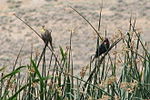Reno Stead Airport

Reno Stead Airport (ICAO: KRTS, FAA LID: RTS, formerly 4SD) is a large public and military general aviation airport located in the North Valleys area, 10 nautical miles (19 km) northwest of the central business district of Reno, in Washoe County, Nevada, United States. A former military installation until 1966, when it was known as Stead Air Force Base, the airport's sole remaining military presence consists of an Army Aviation Support Facility and the 189th General Support Aviation Battalion of the Nevada Army National Guard, flying CH-47 Chinook helicopters. The airport is owned by the Reno Tahoe Airport Authority. The National Plan of Integrated Airport Systems for 2011–2015 categorized it as a general aviation reliever airport.Although most U.S. airports use the same three-letter location identifier for the FAA and IATA, this airport is assigned RTS by the FAA, but has no designation from the IATA (which assigned RTS to Rottnest Island Airport in Rottnest Island, Western Australia). Reno Stead Airport does not have regularly scheduled service, but functions as a general aviation reliever for the nearby Reno–Tahoe International Airport. The airport is used by the Bureau of Land Management as a base for fire fighting aircraft.
Excerpt from the Wikipedia article Reno Stead Airport (License: CC BY-SA 3.0, Authors, Images).Reno Stead Airport
Texas Avenue, Reno Stead
Geographical coordinates (GPS) Address Nearby Places Show on map
Geographical coordinates (GPS)
| Latitude | Longitude |
|---|---|
| N 39.668055555556 ° | E -119.87638888889 ° |
Address
Texas Avenue
Reno, Stead
Nevada, United States
Open on Google Maps





